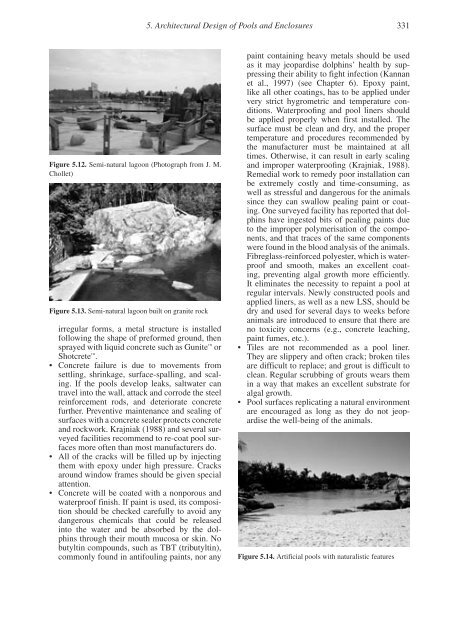Special Issue Survey of Cetaceans in Captive Care
Special Issue Survey of Cetaceans in Captive Care
Special Issue Survey of Cetaceans in Captive Care
Create successful ePaper yourself
Turn your PDF publications into a flip-book with our unique Google optimized e-Paper software.
5. Architectural Design <strong>of</strong> Pools and Enclosures 331Figure 5.12. Semi-natural lagoon (Photograph from J. M.Chollet)Figure 5.13. Semi-natural lagoon built on granite rockirregular forms, a metal structure is <strong>in</strong>stalledfollow<strong>in</strong>g the shape <strong>of</strong> preformed ground, thensprayed with liquid concrete such as Gunite orShotcrete .• Concrete failure is due to movements fromsettl<strong>in</strong>g, shr<strong>in</strong>kage, surface-spall<strong>in</strong>g, and scal<strong>in</strong>g.If the pools develop leaks, saltwater cantravel <strong>in</strong>to the wall, attack and corrode the steelre<strong>in</strong>forcement rods, and deteriorate concretefurther. Preventive ma<strong>in</strong>tenance and seal<strong>in</strong>g <strong>of</strong>surfaces with a concrete sealer protects concreteand rockwork. Krajniak (1988) and several surveyedfacilities recommend to re-coat pool surfacesmore <strong>of</strong>ten than most manufacturers do.• All <strong>of</strong> the cracks will be filled up by <strong>in</strong>ject<strong>in</strong>gthem with epoxy under high pressure. Cracksaround w<strong>in</strong>dow frames should be given specialattention.• Concrete will be coated with a nonporous andwaterpro<strong>of</strong> f<strong>in</strong>ish. If pa<strong>in</strong>t is used, its compositionshould be checked carefully to avoid anydangerous chemicals that could be released<strong>in</strong>to the water and be absorbed by the dolph<strong>in</strong>sthrough their mouth mucosa or sk<strong>in</strong>. Nobutylt<strong>in</strong> compounds, such as TBT (tributylt<strong>in</strong>),commonly found <strong>in</strong> antifoul<strong>in</strong>g pa<strong>in</strong>ts, nor anypa<strong>in</strong>t conta<strong>in</strong><strong>in</strong>g heavy metals should be usedas it may jeopardise dolph<strong>in</strong>s’ health by suppress<strong>in</strong>gtheir ability to fight <strong>in</strong>fection (Kannanet al., 1997) (see Chapter 6). Epoxy pa<strong>in</strong>t,like all other coat<strong>in</strong>gs, has to be applied undervery strict hygrometric and temperature conditions.Waterpro<strong>of</strong><strong>in</strong>g and pool l<strong>in</strong>ers shouldbe applied properly when first <strong>in</strong>stalled. Thesurface must be clean and dry, and the propertemperature and procedures recommended bythe manufacturer must be ma<strong>in</strong>ta<strong>in</strong>ed at alltimes. Otherwise, it can result <strong>in</strong> early scal<strong>in</strong>gand improper waterpro<strong>of</strong><strong>in</strong>g (Krajniak, 1988).Remedial work to remedy poor <strong>in</strong>stallation canbe extremely costly and time-consum<strong>in</strong>g, aswell as stressful and dangerous for the animalss<strong>in</strong>ce they can swallow peal<strong>in</strong>g pa<strong>in</strong>t or coat<strong>in</strong>g.One surveyed facility has reported that dolph<strong>in</strong>shave <strong>in</strong>gested bits <strong>of</strong> peal<strong>in</strong>g pa<strong>in</strong>ts dueto the improper polymerisation <strong>of</strong> the components,and that traces <strong>of</strong> the same componentswere found <strong>in</strong> the blood analysis <strong>of</strong> the animals.Fibreglass-re<strong>in</strong>forced polyester, which is waterpro<strong>of</strong>and smooth, makes an excellent coat<strong>in</strong>g,prevent<strong>in</strong>g algal growth more efficiently.It elim<strong>in</strong>ates the necessity to repa<strong>in</strong>t a pool atregular <strong>in</strong>tervals. Newly constructed pools andapplied l<strong>in</strong>ers, as well as a new LSS, should bedry and used for several days to weeks beforeanimals are <strong>in</strong>troduced to ensure that there areno toxicity concerns (e.g., concrete leach<strong>in</strong>g,pa<strong>in</strong>t fumes, etc.).• Tiles are not recommended as a pool l<strong>in</strong>er.They are slippery and <strong>of</strong>ten crack; broken tilesare difficult to replace; and grout is difficult toclean. Regular scrubb<strong>in</strong>g <strong>of</strong> grouts wears them<strong>in</strong> a way that makes an excellent substrate foralgal growth.• Pool surfaces replicat<strong>in</strong>g a natural environmentare encouraged as long as they do not jeopardisethe well-be<strong>in</strong>g <strong>of</strong> the animals.Figure 5.14. Artificial pools with naturalistic features


